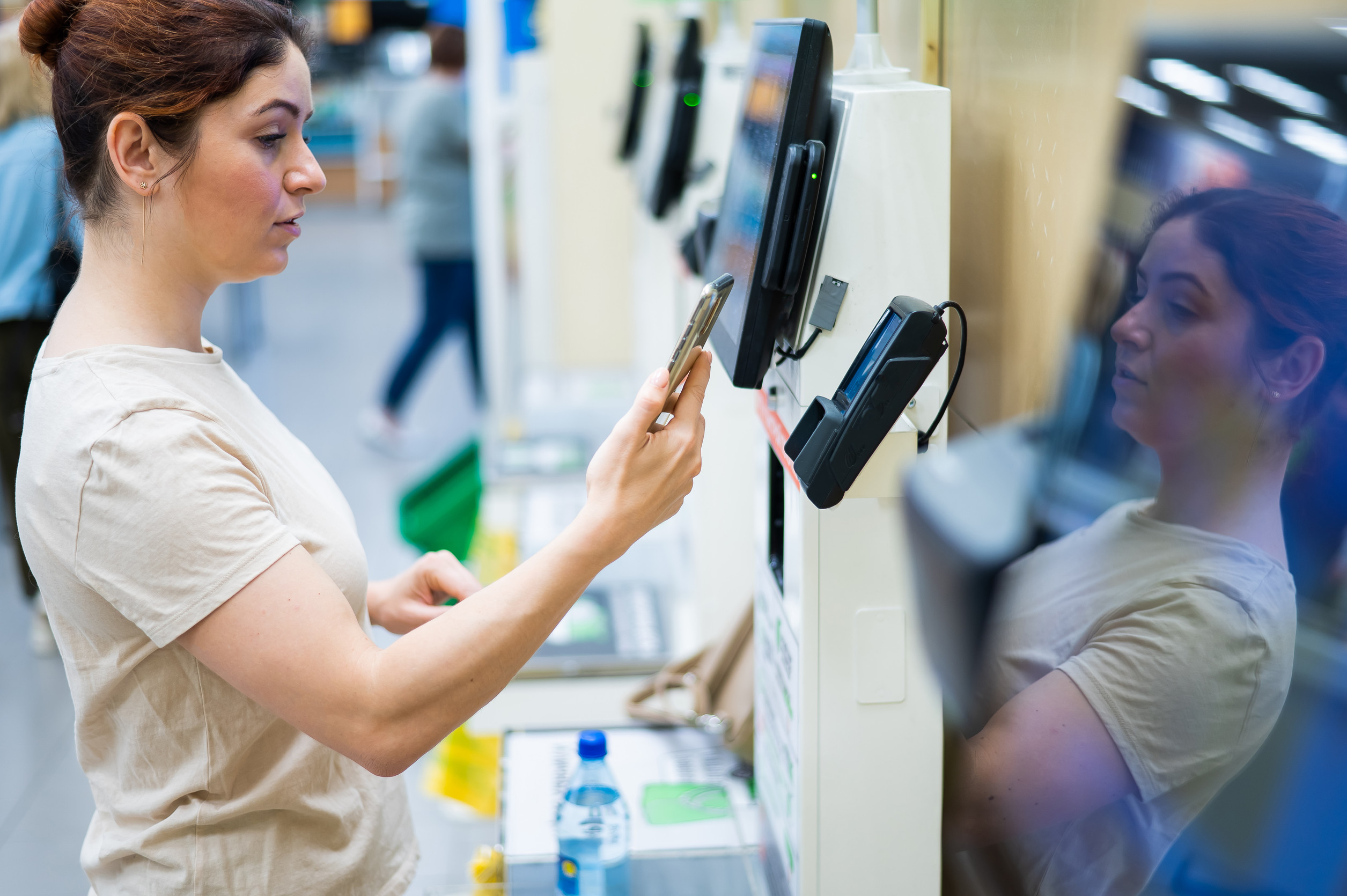
Image Source: 123rf.com
Ever been surprised when a self‑checkout overcharge at the register made your grand total higher than expected? You’re not alone. Between mislabeled sale tags, barcode mix‑ups, and loyalty discounts that vanish in the system, Apple, Kroger, Target, and other big chains have been hit for tens or hundreds of thousands over mistakenly ringing up items for more than the labeled price. That mismatch isn’t just frustrating—it costs real cash every time it happens. Whether you’re scanning produce, clearance, bulk bins, or meat by the pound, learning which specific items are most likely to trigger a self‑checkout overcharge can save you money, time, and the hassle of store complaints.
1. Apples and Other Produce
At self‑checkout, produce is often weighed or keyed using PLU codes, and entering “Gala apples” instead of “Braeburn” could easily produce a self‑checkout overcharge if the sticker price and PLU don’t match. In one Reddit post, shoppers described:
“The scan listed the apples as Gala instead of Braeburn, which were much more expensive.”
Even small shifts in price per pound add up fast. If the cashier or scale misassociates varieties, your cart may ring up higher. Double‑check the PLU sticker or weigh look‑up number—or scan while watching the unit price.
2. Clearance or Expired Sale Tags
Items still carrying old sale or clearance stickers can ring up higher than labeled when scanned—even if the sticker says “Limited Time Offer.” Consumer Reports found that roughly 18% of scanned items at Kroger were priced above the expired shelf tag, resulting in average overcharges of $1.70 per item. At self‑checkout, you may not catch that overcharge until it’s too late. The system quietly applies the regular price instead of the sale price, triggering a common self‑checkout overcharge. Always compare your receipt total to what was printed on the shelf tag before leaving the kiosk area.
3. Tagged Specials That Didn’t Sync to Register
Retail inspections have found up to 9% of items at Target and Walmart overcharged at scan—most often due to advertised deals not syncing with the register database. These mismatches often occur at the self‑checkout because it’s handled by a different electronic label and update process. That disconnect leads to what shoppers recognize as a self‑checkout overcharge on even basic groceries or household essentials. When a promotional sign isn’t removed or the backend update fails, the kiosk charges the higher standard rate. Customers may not notice until after they’ve left the kiosk unless they vigilantly review each line item.
4. Bulk Bins and Loose Items
When you grab items from the bulk bins—coffee beans, candies, nuts—they depend on look-up codes that vary by bin. Mis-entering a look-up code similar in number to an adjacent bin—for example, “BB‑322” instead of “BB‑323”—can lead to an unnoticed price hike. This type of error often contributes to a self‑checkout overcharge because it scans at a higher rate per pound than what was printed. Some stores also reuse codes for seasonal items and forget to update the label in the system. If that code wasn’t updated in the register after a price change, you still get charged the old rate—or worse, a rate for something entirely different.
5. Deli or Meat by the Pound
Items sold by weight in the deli, meat, or seafood sections can ring up with added pricing errors if the posted price per pound changed but the register wasn’t updated. Government inspections in North Carolina found some dry‑cleaning and grocery stores with error rates as high as 3.67% on price tags not matching the register pricing. At self‑checkout, that discrepancy results in a self‑checkout overcharge when the machine calculates based on an old or default price instead of the fresh data. These products usually have bagged scale labels—so always compare your printed scale sticker price to the shelf post before scanning. If the total is higher, cancel the scan and flag a staffer to reprice the item.
6. Digital Coupons or Loyalty Prices Not Applied
When loyalty coupons or digital app discounts are set to auto-apply, sometimes the local system fails to sync them to the kiosk. That glitch causes the register to charge full price—and into a self‑checkout overcharge situation even if the scanner displays a discounted price on-screen. CBS News warned that these mismatches are more common than customers realize and improperly cause overcharges at self‑checkout. If your final total looks wrong, don’t walk away—go to customer service and ask them to honor the coupon. Take screenshots of your app or sales flyer to support your case.
7. “Buy One Get One” (BOGO) and Multi‑Buy Deals
With promotions like BOGO or 2-for‑1 offers, self‑checkout sometimes only recognizes the first scan or the last scan, triggering a self‑checkout overcharge if you don’t manually increase the quantity. The system may either ignore the free second item entirely or miscompute the sale price until you hit “2” rather than scanning both. Without the BOGO logic applied, you might be charged full price for both items. Unless the kiosk displays promotional pricing clearly after each scan, you may not notice until you reach the total screen. Always double-check such deals before pressing “Pay”—and ask for help if you only see the full price per unit.
8. Imported or Specialty Products with Mis‑synced Barcodes
Items imported or sold seasonally—like premium cheeses, gluten‑free snacks, or imported baked goods—sometimes have UPCs that don’t match the store’s normal database or that scan at a generic default price higher than expected. At self‑checkout, that kind of mismatch causes a self‑checkout overcharge, often for just a few cents or dollars—but consistently. Seasonal price tags may display the discounted price while the database still has last season’s full‑price SKU. Some stores print new shelf tags but forget to update the register. These errors might only show up for specialty lines, so they can go unnoticed by casual shoppers until reflected on the receipt.
9. Weight‑Violation Alerts That Add Surcharge
Modern self‑checkout systems often include weight scales that trigger an alert if item weight doesn’t match the expected scan weight—or if the system assumes unscanned items in the bag area—leading to surcharges or manual overrides. Retailers using these surveillance-backed systems sometimes force customers to rescan or weigh items again—and that can accidentally apply a higher item charge than the original price, especially if the wrong override code is entered. Such incidents are a subtle form of self‑checkout overcharge, since it involves extra logic beyond scanning. Customers often walk off annoyed—but the overcharge may remain invisible unless questioned. If prompted to rescan by the system—and the price changes—ask for clarification or a price correction from a team member.
Your Receipt Is Your Best Friend
Every time you self‑checkout, your receipt is the only proof you’ll have of a self‑checkout overcharge. Always glance at the screen during scanning, then review the full receipt before walking off—you can politely call a clerk over to fix any higher-than-labeled totals. Many states legally require stores to honor the shelf price or refund the overcharge, especially if it looks like an error in the system. Save digital coupons, take a snapshot of sale tags, and ask for price adjustments on the spot so you don’t pay for automation mistakes. Being vigilant turns self‑checkout into self‑protection—and saves you from paying too much.
What’s the biggest or most surprising scanner price mismatch you’ve ever caught at self‑checkout? Let us know in the comments!
Read More
Do Self-Checkout Machines Penalize You for Using Coupons?
Why Arizona Shoppers Are Reporting New “Shrinkflation” Scams at Self-Checkout
